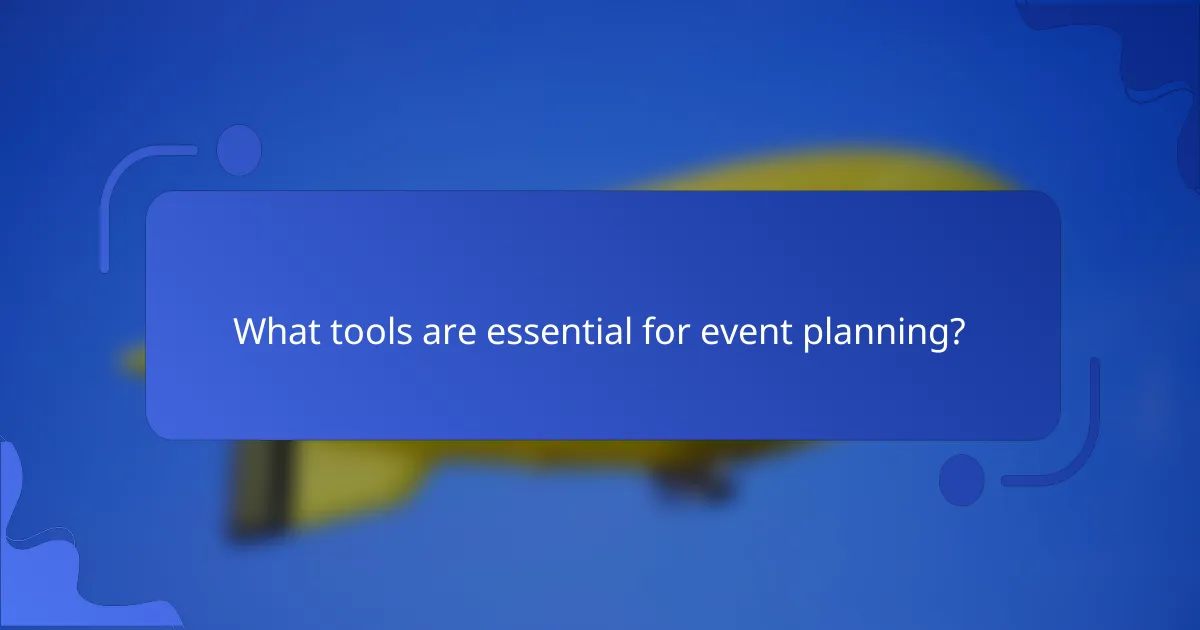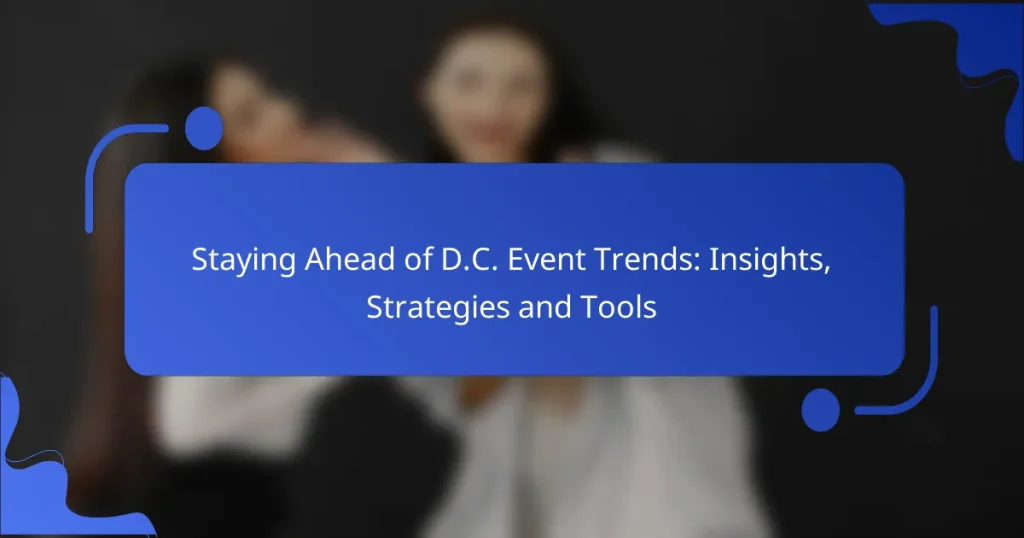Staying ahead of event trends in D.C. requires an understanding of hybrid formats, sustainability, and the integration of advanced technology. By leveraging digital tools and creating interactive experiences, event organizers can enhance engagement and ensure their events meet the evolving preferences of attendees. Embracing these strategies not only fosters participation but also elevates overall satisfaction and retention.

What are the latest event trends in D.C.?
The latest event trends in D.C. focus on hybrid formats, sustainability, and advanced technology integration. These trends reflect changing attendee preferences and the need for more efficient, eco-friendly practices in event planning.
Hybrid events
Hybrid events combine in-person and virtual elements, allowing broader participation. This format caters to attendees who prefer attending from home while still engaging those present at the venue.
To effectively implement hybrid events, consider using reliable streaming platforms and interactive tools to facilitate engagement. Ensure that both audiences receive equal value, whether they are online or on-site.
Focus on sustainability
Sustainability is becoming a crucial aspect of event planning in D.C., with organizers prioritizing eco-friendly practices. This includes reducing waste, using sustainable materials, and choosing venues that prioritize green initiatives.
To enhance sustainability, consider digital ticketing, local catering options, and waste reduction strategies. Engaging attendees in sustainability efforts can also enhance their experience and promote a positive brand image.
Increased use of technology
The integration of technology in events is on the rise, with tools like event apps, virtual reality, and AI-driven analytics enhancing the attendee experience. These technologies streamline processes and provide valuable insights into attendee behavior.
When adopting new technologies, ensure they align with your event goals and enhance engagement. Training staff on these tools is essential to maximize their effectiveness and ensure a smooth experience for all participants.

How to leverage technology for D.C. events?
Leveraging technology for events in D.C. involves utilizing various digital tools to enhance planning, engagement, and execution. By integrating event management software, virtual reality experiences, and live streaming platforms, organizers can create more dynamic and accessible events.
Event management software
Event management software streamlines the planning process by offering tools for registration, ticketing, and attendee management. Popular options include platforms like Eventbrite and Cvent, which can handle everything from guest lists to payment processing.
When selecting software, consider features such as user interface, customer support, and integration capabilities with other tools. A good practice is to choose a solution that allows for easy data export, which can be useful for post-event analysis.
Virtual reality experiences
Virtual reality (VR) experiences can significantly enhance attendee engagement by offering immersive environments. For example, VR can transport participants to different locations or simulate real-world scenarios relevant to the event theme.
To implement VR, ensure you have the necessary hardware and software, and consider offering guided sessions to help attendees navigate the technology. Keep in mind that while VR can be captivating, it may require additional budget and technical support.
Live streaming platforms
Live streaming platforms enable remote participation, making events accessible to a broader audience. Tools like Zoom, YouTube Live, and Facebook Live allow organizers to broadcast sessions in real-time, increasing reach and engagement.
When using live streaming, ensure you have a reliable internet connection and test all equipment beforehand. Additionally, consider offering interactive elements, such as Q&A sessions, to keep online viewers engaged.

What strategies can enhance attendee engagement?
Enhancing attendee engagement involves creating interactive experiences, fostering networking opportunities, and delivering personalized content. These strategies not only increase participation but also improve overall satisfaction and retention at events.
Interactive sessions
Interactive sessions encourage active participation from attendees, making them feel more involved. Techniques such as live polls, Q&A segments, and breakout discussions can transform a passive audience into engaged participants.
Consider using tools like Slido or Mentimeter to facilitate real-time feedback and interaction. Aim for at least one interactive element in each session to maintain energy and interest.
Networking opportunities
Providing ample networking opportunities is crucial for attendee engagement. Structured networking sessions, such as speed networking or themed meetups, can help participants connect meaningfully.
Utilize apps that facilitate connections based on shared interests or goals. Ensure that these opportunities are well-promoted in advance to maximize participation and allow attendees to prepare effectively.
Personalized content
Delivering personalized content can significantly enhance engagement by catering to individual interests and needs. Use data from registration forms or past interactions to tailor sessions and materials to specific audience segments.
Consider offering multiple tracks or sessions that align with various interests, allowing attendees to choose what resonates most with them. This approach not only increases relevance but also encourages deeper engagement with the material presented.

How to choose the right venue in D.C.?
Selecting the right venue in Washington, D.C. involves considering factors like capacity, accessibility, and location. A well-chosen venue can enhance the event experience and ensure it meets the needs of all attendees.
Capacity and layout considerations
When choosing a venue, first assess the expected number of attendees to ensure it can comfortably accommodate them. Venues in D.C. typically range from intimate spaces for small gatherings to large halls for hundreds of guests.
Consider the layout as well; an open floor plan may be ideal for networking events, while a theater-style setup works better for presentations. Always verify that the venue can be configured to suit your event’s specific needs.
Accessibility features
Accessibility is crucial for ensuring all guests can participate fully. Check if the venue complies with the Americans with Disabilities Act (ADA), which mandates features like ramps, elevators, and accessible restrooms.
Additionally, inquire about services such as sign language interpretation or assistive listening devices, which can enhance the experience for attendees with disabilities.
Location benefits
The venue’s location can significantly impact attendance and engagement. Choose a site that is easily accessible via public transportation, as D.C. has a robust metro system that can accommodate many visitors.
Proximity to hotels, restaurants, and attractions can also enhance the overall experience for attendees, making it easier for them to network and enjoy their time in the city. Aim for venues that are in vibrant neighborhoods to capitalize on these benefits.

What are the key metrics for measuring event success?
Key metrics for measuring event success include attendee satisfaction, engagement levels, and return on investment (ROI). These metrics provide insights into how well an event met its objectives and the overall experience for participants.
Attendee satisfaction surveys
Attendee satisfaction surveys are essential for gauging how participants felt about the event. These surveys typically include questions about the event’s content, organization, and overall experience. Aim for a response rate of at least 20-30% to ensure reliable data.
Consider using a mix of quantitative ratings and qualitative feedback to capture a comprehensive view. For example, a scale from 1 to 5 can quantify satisfaction, while open-ended questions allow attendees to express specific thoughts.
Engagement analytics
Engagement analytics track how actively participants interacted with the event’s content and activities. Metrics such as session attendance, participation in Q&A sessions, and social media interactions can provide valuable insights. Tools like event apps can help gather this data in real-time.
Look for trends in engagement, such as which sessions had the highest attendance or most interaction. This information can guide future event planning by highlighting what resonates most with attendees.
ROI calculations
ROI calculations assess the financial success of an event by comparing the costs incurred to the revenue generated. To calculate ROI, use the formula: (Net Profit / Total Costs) x 100. A positive ROI indicates that the event was financially beneficial.
Consider both direct revenue, such as ticket sales and sponsorships, and indirect benefits, like brand exposure and lead generation. Tracking these elements can help refine future budgeting and marketing strategies for events.

What tools are essential for event planning?
Essential tools for event planning streamline processes, enhance communication, and improve attendee engagement. Key tools include ticketing platforms, virtual meeting software, and project management applications to ensure a smooth event experience.
Eventbrite for ticketing
Eventbrite is a popular platform for managing ticket sales and registrations. It allows event planners to create customized event pages, set ticket prices, and track sales in real-time. This tool is particularly useful for events with multiple ticket types, such as early bird, VIP, or group discounts.
When using Eventbrite, consider integrating it with your marketing efforts to maximize reach. Promote your event through social media and email campaigns linked directly to your Eventbrite page. This can significantly boost ticket sales and attendance.
Zoom for virtual components
Zoom is an effective tool for incorporating virtual elements into your events, especially in hybrid formats. It allows for seamless video conferencing, webinars, and breakout sessions, making it easier to engage remote attendees. Ensure you have a reliable internet connection and test your setup before the event to avoid technical issues.
To enhance the virtual experience, consider using Zoom’s features like polls and Q&A sessions. These interactive elements can keep participants engaged and provide valuable feedback. Additionally, familiarize yourself with Zoom’s security settings to protect your event from unwanted disruptions.


